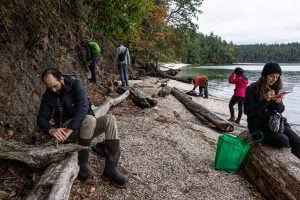
Environment
The sixth extinction
The planet is in the midst of drastic biodiversity loss that some experts think may be the next great species die-off. How did we get here and what can be done about it?
- 4895 words
- 20 minutes
This article is over 5 years old and may contain outdated information.
Wildlife

A new species of flying squirrel has been found in coastal forests of the Pacific Northwest. Before now, this “new” species was thought to have been the already-known northern squirrel.
Brian Arbogast, an associate professor of biology at the University of North Carolina, discovered the new cryptic species (distinct species that look indistinguishable from each other) as he was examining the genetic information of the Burke Museum’s collections of flying squirrels in Seattle.
“It’s a significant finding for the general school of biodiversity and appreciation of evolutionary history,” says co-author Jim Kenagy, the emeritus curator of mammals for the Burke Museum. “In terms of speciation, it tells us that some series of events during Pleistocene – which occurred 1-2 million years ago – lend to a separation of lineage on the coast.”
With this discovery, there are now 45 species of flying squirrel known to exist worldwide.
Humboldt brag: new name for flying squirrel
Arbogast and his team have proposed a new name for this furry critter: Humboldt’s flying squirrel. The name is a nod to the well-known Prussian naturalist Alexander von Humboldt.
The new species can be found along the Pacific coast, from southern British Columbia to southern California, which overlaps with the habitat range of the northern flying squirrel. The other species found in North America, the southern flying squirrel, is found in the eastern parts of North America and southeastern parts of Canada.
Lanna Desantis, a PhD candidate at the Trent University who studies the ecology and behaviour pressures of flying squirrels, says the discovery could also provide interesting future comparisons to eastern Canadian populations.
“Here, where we study them, there is no real physical barrier that would isolate a population for a long enough time to have them sort of diverge,” says Desantis. “But I think there is still a lot of connectivity on this side of the continent at least for each species on their own.”
The study examined specimens collected throughout the Pacific Northwest. Analyses of the mitochondrial DNA helped distinguish the Humboldt from the northern flying squirrel, and showed no evidence of any hybridization occurring between the two species.
That does not mean, says Kenagy, that this couldn’t be revealed in future studies.
“Being situated in Washington I’m in the middle of question mark, in terms of which species are which. Although we’ve had a successful publication, it remains a question for some of the distinctions of where the species overlap and what that means.”
The research team has not yet determined a list of criteria, features or behaviours, that differentiate the Humboldt flying squirrel from the northern flying squirrel. One possibility could be ecological distinctions, such as foraging or behavioural differences.
These criteria will help the archival team and collections manager at the Burke Museum sort through their collection of northern squirrels to ensure Humboldt’s are properly identified.
“Since we developed the collection, anything we obtained from Alaska, B.C., the western part of Canada—we’ve called it northern flying squirrel. They are labeled 100 per cent as northern flying squirrel, but now we have to unravel that.”
Are you passionate about Canadian geography?
You can support Canadian Geographic in 3 ways:

Environment
The planet is in the midst of drastic biodiversity loss that some experts think may be the next great species die-off. How did we get here and what can be done about it?

People & Culture
Naming leads to knowing, which leads to understanding. Residents of a small British Columbia island take to the forests and beaches to connect with their nonhuman neighbours

Wildlife
An estimated annual $175-billion business, the illegal trade in wildlife is the world’s fourth-largest criminal enterprise. It stands to radically alter the animal kingdom.

Wildlife
This past summer an ambitious wildlife under/overpass system broke ground in B.C. on a deadly stretch of highway just west of the Alberta border. Here’s how it happened.